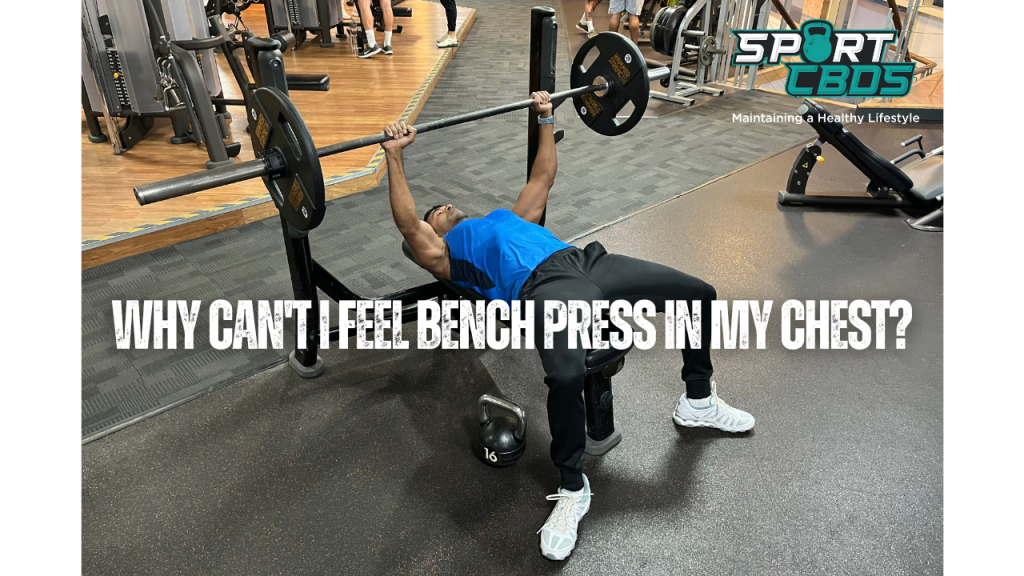
Overcoming Activation Barriers: Why Can’t I Feel Bench Press in My Chest?
The bench press is often hailed as the king of upper body exercises. Walk into any gym, and you’ll likely see someone, somewhere, pushing weight on a bench.
It’s a staple in bodybuilding, powerlifting, and general fitness routines. The primary target? The chest muscles. Yet, a common concern many lifters share is not feeling the bench press in their chest.
Instead, they feel it in their arms, shoulders, or even their back. Why does this happen? Let’s delve deeper.
Why Can’t I Feel Bench Press in My Chest?
The sensation of not feeling the bench press in the chest, despite it being a primary chest exercise, is a common concern among many lifters. This issue often stems from improper form and technique. When the bench press is not executed correctly, other muscles, such as the triceps or shoulders, might take over, reducing the activation of the chest muscles. Factors like a too-narrow grip, not retracting the shoulder blades, or flaring the elbows can shift the emphasis away from the chest. Additionally, not maintaining a slight arch in the back can lead to reduced chest activation and potential shoulder strain. It’s crucial to prioritize proper form and, if in doubt, seek guidance from fitness professionals to ensure the chest is effectively targeted during the bench press.
The Importance of Proper Form
The Role of Form in Targeting the Right Muscles
Proper form is the cornerstone of any exercise, and the bench press is no exception. When executed correctly:
- The chest muscles, or pectorals, become the primary movers.
- The shoulders and triceps play a supporting role, assisting the chest.
- The back provides a stable platform from which to push.
However, deviations from the correct form can shift the emphasis away from the chest. For instance:
- Too narrow a grip: This can place more emphasis on the triceps.
- Elbows flared out: This can stress the shoulders more than necessary.
- Not touching the chest: This can reduce the range of motion, not allowing the chest to work through its full capacity.
The Dangers of Improper Form
While targeting the wrong muscles is a concern, the dangers of improper form extend beyond just muscle activation.
Joint Stress: Incorrect form, especially with heavy weights, can place undue stress on the shoulders and elbows. Over time, this can lead to painful conditions like tendinitis or even more severe injuries.
Muscle Imbalances: Continually pressing with poor form can lead to muscle imbalances. For example, if the triceps are always taking over, they might develop disproportionately to the chest.
Reduced Effectiveness: If you’re bench pressing to develop a strong, muscular chest but you’re not feeling it in your chest, you’re not getting the most out of the exercise.
While the bench press is a powerful exercise for chest development, its effectiveness hinges on proper form. Ensuring you’re pressing with the right technique not only maximizes muscle activation but also keeps you safe from potential injuries.
Arching Your Back: Myth vs. Reality
The bench press, being a staple in most strength training routines, has seen its fair share of debates. One of the most hotly contested topics is the practice of arching the back. Is it a cheat technique, or is there a scientific basis behind it?
The Debate Around Arching the Back
Pro-Arch Camp: Advocates believe that a slight arch can enhance chest activation and reduce shoulder strain.
Anti-Arch Camp: Detractors argue it’s a cheat method that reduces the range of motion and can be harmful to the spine.
Scientific Reasons for Arching the Back
Research and biomechanics offer some insights:
Chest Activation: An arched back can change the angle of the press, placing more emphasis on the upper chest.
Shoulder Health: The arch can reduce the extent to which the upper arm bone (humerus) travels behind the body, potentially reducing shoulder strain.
Flat Back and Shoulder Complications
While a flat back might seem like the “natural” way to bench, it’s not without its issues:
Shoulder Overextension: A flat back can cause the arms to reach too far back at the bottom of the press, stressing the shoulder joint.
Reduced Chest Activation: Without the slight angle an arch provides, the lower chest might bear the brunt of the load, reducing upper chest activation.
Safety Concerns
Like any technique, there are right and wrong ways to arch:
Excessive Arching: A high arch where only the head and hips touch the bench can be dangerous for the spine.
Controlled Arching: A slight, controlled arch with the feet firmly on the ground and the core engaged is generally considered safe.
Related: Bench Press Showdown: Should You Do Flat and Incline Bench Press on the Same Day?
Steps to Target Your Chest in Bench Press
To truly harness the power of the bench press for chest development, technique is paramount. Here’s a step-by-step guide:
1. Positioning Your Eyes Below the Bar
This ensures you’re in the right starting position and sets the stage for a vertical bar path.
2. Proper Foot Placement
Feet should be flat on the ground, providing stability.
Position them slightly back, allowing for a natural arch in the lower back.
3. Arching Your Back and Keeping Glutes on the Bench
As discussed, a slight arch can optimize chest activation.
Ensure your glutes remain in contact with the bench for stability and safety.
4. Pulling Shoulders Back and Down
This “packed” shoulder position reduces shoulder strain and enhances chest activation.
5. Hand Placement and Unracking the Weight
Grip should be slightly wider than shoulder-width for optimal chest activation.
When unracking, use a spotter or ensure the bar is directly above your chest to start.
Incorporating these steps can make a world of difference in how the bench press feels and which muscles are activated. Remember, consistency in technique is key.
Safety and Discomfort Considerations in Bench Pressing
Weightlifting, while immensely beneficial, comes with its own set of challenges. The bench press, being a compound movement, requires special attention to ensure safety and minimize discomfort.
Prioritizing Safety in Weightlifting
Warm-Up: Always start with a thorough warm-up to prepare your muscles and joints.
Proper Form: As emphasized, the right technique can prevent injuries and ensure you’re targeting the intended muscles.
Listen to Your Body: If something feels off, it probably is. Don’t push through pain.
Potential Discomfort When Arching the Back
Some individuals might feel discomfort in the lower back when trying to maintain an arch.
This can be due to tight hip flexors or a weak core.
It’s essential to differentiate between discomfort and pain. The former might be okay, but the latter is a warning sign.
The Risk of Shoulder Damage vs. Back Discomfort
Incorrect bench press form can lead to shoulder injuries, especially if the arms are flared out too much.
While back discomfort from arching is a concern, shoulder injuries can be more debilitating and take longer to heal.
Consulting with a Personal Trainer for Guidance
If you’re unsure about your form or experience consistent discomfort, it’s wise to consult with a professional.
A personal trainer can provide real-time feedback and corrections.
Bench Press and Grip Strength
Grip strength plays a pivotal role in exercises like the bench press. A strong grip can enhance stability during the lift, ensuring that the primary focus remains on the chest muscles. When the grip is weak, other muscles might compensate, leading to reduced chest activation.
Enhanced grip strength can improve overall lifting performance, indirectly emphasizing the activation of target muscles like the chest. For those looking to improve their grip strength, tools like the grip strengthener can be beneficial.
Additionally, products from Sport CBDs can aid in recovery and muscle relaxation, further optimizing your bench press experience.
Related: Why Do I Feel Chest Flys in My Wrist? Why They Hurt and How to Fix It
FAQs on Bench Pressing and Chest Activation
Why do I feel the bench press more in my arms than my chest?
This can be due to a narrow grip or not retracting the shoulder blades. It might also indicate that your triceps are taking over the movement.
How can I ensure I’m targeting my chest muscles during bench press?
Focus on form: retract the shoulder blades, maintain a slight arch, and use a grip slightly wider than shoulder-width.
Is it safe to arch my back during bench press?
A slight, controlled arch is generally safe and can enhance chest activation. Excessive arching can be harmful.
What are common mistakes people make during bench press that affect muscle targeting?
Common mistakes include flaring the elbows, using too narrow a grip, and not maintaining a stable base with the feet.
Are you supposed to feel your chest when bench pressing?
Yes, the chest should be the primary muscle group activated during the bench press.
How do I activate my chest for bench press?
Focus on squeezing the chest muscles, especially at the top of the movement. Ensure your form is correct.
Why don’t I feel my chest when doing chest workouts?
This can be due to incorrect form, muscle imbalances, or not using a full range of motion.
Why do I have no sensation in my chest?
If you genuinely feel no sensation, it might be a medical concern and not related to the exercise. It’s essential to consult with a healthcare professional.
Final Thoughts…
Ensuring the right form in bench pressing guarantees optimal muscle targeting and efficient strength building with each repetition. However, missteps in technique can result in minor to severe injuries, emphasizing the importance of sticking to proper form to minimize hazards.
The realm of fitness is ever-evolving, so it’s crucial to keep abreast of the newest findings and methods. If ever uncertain about technique, reaching out to a fitness specialist or personal trainer can provide seasoned feedback.
Moreover, while pushing boundaries is inherent to progress, discerning between beneficial discomfort, like post-workout soreness, and harmful pain, such as acute joint pain, is crucial.
To sum it up, the bench press, when done right, is a powerful ally in chiseling and fortifying the chest. However, if approached carelessly, it can be counterproductive. Emphasizing technique, safety, and ongoing education is vital to harness its true benefits.
Do you struggle to feel your chest when doing bench press? Have our tips been beneficial to your training? We’d love to hear your feedback, so please share your thoughts in the comments section below.
If you’re a sports enthusiast who utilizes CBD for optimal recovery after intense workouts, then you’ve found your tribe. Welcome to Sport CBDs, where we push our limits in training and prioritize recovery in the most effective way possible.
We regularly share workout routines on our YouTube channel and offer a range of health and fitness products designed to give you that competitive edge.
Why not explore the high-quality CBD products we proudly feature on our site? Visit the Sport CBDs Store by clicking here. In addition to CBD, we also offer an array of fitness clothing and yoga accessories to complement your active lifestyle.
Until next time, we wish you the best in your fitness journey. Remember, your progress is our passion. Stay strong and keep pushing!


